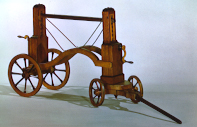
36.1 x 56.2 x 20.5
Carved wood and brass
CAT. 1824 : D.II.31
Modelo d'um carro, que serve para conduzir pedras lavradas, sem que soffrão algum damno na sua conducção, chamado por seu Author em francez Gabrielle. Jornal de Physique de Rozier de 1799.
Model of a cart used to carry stonework without causing it any damage, called by its inventor in French Gabrielle. Journal de Physique de Rozier, 1799.
Above each of the two axles of this cart, designed for the transport of carved stone blocks, there is a column, inside each of which is a cogwheel turned by an exterior handle. The cogs engage with the lateral teeth of vertical bars, which can be raised and lowered inside the columns.
At the top of each of the toothed bars there is a horizontal wooden beam connecting the vertical columns. Each end of the beam fits into a slot running practically the whole length of both columns, and goes up and down along with the toothed bar.
Also connecting the two columns, but at a lower level than the movable beam, and at each side of the cart, are two other beams curving upwards. Two brass rods connect the middle of these beams to the columns, giving greater rigidity and stability to the assembly.
At the front of the cart is a circular platform which can turn on a vertical axis, and on which are mounted the front axle of the wheels and the shaft used for pulling the cart.
The shape and arrangement of the cart suggest that it would have been manoeuvred so that the masonry blocks were underneath the curved part of the two lower beams. One block would then be tied by a rope to the movable horizontal beam, which would be at its lowest position. Once the stone was firmly attached, the beam would be raised by turning the two handles simultaneously, thereby lifting the stone from the ground, and the cart would be ready to move.
Montmorillon, Comte de, "Description d'un fardier nommé la Gabrielle, ou voiture propre á transporter de gros blocs de pierre, tout taillés & sculptés, sans crainte qu'ils soient endommagés", Observations sur la physique naturelle et sur les arts, Vol. II, p. 522, 1787. Paris, Bureau du Journal de Physique.